 IST,
IST,
Pre-Colonial India & Princely States: Coinage
The decline of the Mughal Empire commenced soon after the death of Aurangzeb. For a while, the military successes of the Marathas gave rise to the feeling that they would fill the vacuum left by the Mughals and don the imperial mantle. This was not to be. In the anarchy that followed, regional forces tended to reassert themselves and states with ancient antecedents, many of which had been independent during Medieval times, like the states of Rajputana, re-emerged. The dilution of central authority prompted Provincial Governors of the Mughals, to assume independence (e.g., the states of Avadh and Hyderabad). The turbulence of the times also gave rise to Military Adventurers who through force carved out kingdoms for themselves, like Scindia (Gwalior), and Hyder Ali (Mysore). Finally, there were ‘states of convenience’, - titular states whose ruling dynasty was supported either by the British (e.g., the Wodeyars) or the regional hegemon in the interest of high politics. When the British Crown took over the administration from the East India Company in 1858 there were over a hundered Princely States which were issuing coins nominally in the name of the Mughal Emperor. With the deportation of the last Mughal Emperor Bahadur Shah to Rangoon, the native rulers gradually replaced the Mughal superinscriptions on their coins with the name or portrait of the Queen of England as an expression of acceptance of British supremacy. Some coins like those of Mewar inscribed the word ‘Dosti London’ i.e. ‘Friends of London’ on their coins. The British over time curtailed the rights of the the Native States to strike their own coins. Representative Coinage of some of the States are depicted below.
The Maratha Confederacy
While the Marathas have had a long history, they came into the limelight in the seventeenth century led by the charismatic leader Shivaji. The Maratha Confederacy consolidated itself after Aurangzeb’s death in 1707 AD. Their military successes saw them overrun most of India by 1738 AD. The Marathas were set to be the only power in India to take on the Imperial mantle and build an Indian empire. Their fortunes suffered a setback with the battle of Panipat in 1761 AD. They, however, retained their hegemony over the Deccan till the end of the century. With the decline of central power, Maratha families established the states of Baroda, Gwalior, Indore, etc. As regards coinage, Shivaji first issued coins in 1664 AD when he assumed the title of Raja. Coins were again issued to commemorate his coronation at Raigadh in 1674 AD. These coins are rare. Maratha Mints and coinage were consolidated around the middle of the eighteenth century. Three types of Rupees were in circulation during this period, viz., the Hali Sicca, the Ankushi rupee which was the standard rupee of Pune, and the Chandori rupee which was on par with the Ankushi.
Coins of the Marathas








Awadh
The Province of Awadh, situated in Northern India, was governed by Nawab-Wazirs on behalf of the Mughal Emperor from around 1720 AD. With the decline of the Mughal Empire, the British Governor General, the Marquis of Hastings, persuaded Ghaziuddin Haidar, the Nawab-Wazir of Awadh, to cast off Mughal suzerainty and declare himself independent. Ghaziuddin was crowned in 1819, but the State of Awadh whose capital Lucknow, laid claimed the title of the cultural capital of India, did not survive even four decades. Despite Ghaziuddin’s proclamation of independence, the first issues continued in the name of the Mughal Emperor, with the Awadh coat of arms on the reverse, before independent coins were issued. The coat of arms was imitative of the English and marked a departure from the traditional Mughal designs. Nasiruddin Hyder, Muhammed Ali, and Wajid Ali succeeded Ghaziuddin. The monetary system consisted of the gold ashrafi, (half, quarter, eighth and sixteenth of an ashrafi), the silver rupee with similar five denominations and the copper fulus. The defeat of the Nawab of Awadh at the Battle of Buxar (1764), precipitated the decline of the Kingdom. Wajid Ali Shah, the last Nawab was forced to abdicate in 1856 by Lord Dalhousie. During the 1857 uprising, the battle of Lucknow was one of the most bitterly fought battles. The revolutionaries are said to have minted coins in the name of the Nawab-Wazarat.
Coins of Awadh

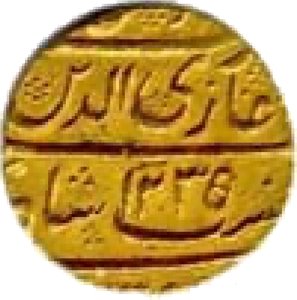

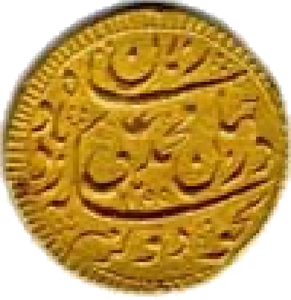
Mysore
The Kingdom of Mysore was situated in Southwest India and was ruled by various Hindu dynasties. In 1761, Haider Ali a military adventurer deposed the Wodeyar ruler and proclaimed himself King. In the region, coins of both the Mughal and Vijayanagar standards were current. His coin issues coins of the pagoda types continued to carry the motifs and iconographic forms of the Vijayanagar period (e.g., Hara-Gauri) with his initial, the letter ‘He’ on the reverse. Tipu, his son, succeed him and assumed the title of Sultan. He introduced various innovations and new varieties in his coinage, continuing with the pagodas, the mohurs, and introduced his own standards. An interesting feature of his coins is that they do not bear his name. Tipu Sultan, a progressive ruler, was one of the few Indian princes to perceive the imperial designs of the British and oppose them; he, however, was slain in the battle of Srirangpatanam in 1799 after which the British reinstated Krishna Raja Wodeyar as King of Mysore. Krishna Raja Wodeyar continued to issue coins of the Vijayanagar and Mughal standards. The gold coins carried the Hara-Gauri motif and the King’s name on the reverse. The silver coins were in the Mughal tradition, bearing the name of the Mughal Emperor, Shah Alam II on the obverse and the name of the mint on the reverse. Some of the smaller fraction coins carried the image of the deity Chamunda, the family deity of the Wodeyar family; other coins carried motifs drawn from nature and inscriptions in Nagri, Persian, Kannada, and English at various points of time.
Coin of Hyder Ali


Rupee of Tipu Sultan
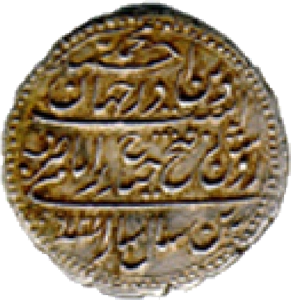

Coins of the Sikhs
Guru Nanak laid the foundations of a religious community, which gradually metamorphised into the Sikh Empire, a formidable military power in North Western India. This transformation was brought about on account of continued Mughal oppression. Constant harassment by the Mughal forces because of the failure of the Sikhs to embrace Islam, led to the emergence of Sikh militarism. However it was with the defeat of Ahmad Shah Durrani at Sirhind in 1710, that the Sikh league also known as Khalsa, came into its own. The whole tract of land between Jhelum and Sutlej was divided among the Sikh chieftains. Around 1777 AD, coins were issued from Amritsar without the name of the Mughal Emperor and were called ‘Nanak Shahi’. These coins bore the name of Guru Gobind Singh, the tenth and the last Guru of the Sikhs. The most distinguished statesman amongst the chieftains was Ranjit Singh who successfully recaptured Amritsar, Ludhiana, Multan, Kashmir and Peshawar. The treaty of 1809, with the British, confirmed his right to rule the tracts he had occupied south of Sutlej. However, after his death, the Sikh Empire began to deteriorate and was finally annexed to the British Empire in 1849. Most coins struck during the reign of Ranjit Singh bear a large leaf on one side and bear Persian legends. He also introduced coins with Gurumukhi legends, mostly of the copper variety.
Coins of the Sikhs





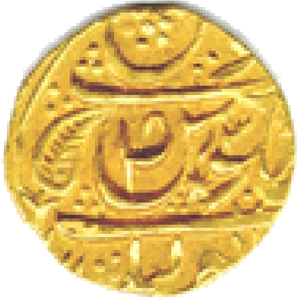
Hyderabad
The Princely State of Hyderabad was founded around 1724 when Mir Qamar-ud-Din, the Mughal Viceroy of the Deccan, assumed independence under the title of Asaf Jah and founded the dynasty of the Nizams of Hyderabad. In the post 1857 era, the State of Hyderabad was one of the largest Princely States in India and later came to be known as the ‘Dominion of His Exalted Highness, the Nizam’. The State which covered territories presently included in Andhra Pradesh, Maharashtra, and Karnataka was assimilated into the Indian Union in September 1948. In matters of currency and coinage, the coins of the Nizams were issued in the name of the Mughal Emperor till 1858 when a coin legend was introduced with the name of the founder of the state, Asaf Jha. Thereafter, they were struck independently and the new coins were termed the ‘Hali Sicca’, i.e., the current coins. In 1903-04 coins were machine struck for the first time. These coins featured the Charminar on the obverse with Persian inscription Nizam-ul-mulk Bahadur Asaf Jah around it. The reverse carried the value. These coins confirmed to the British coins in denominations and metals.
Ashrafi
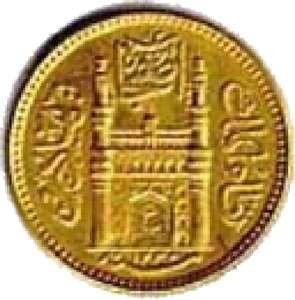

Rupee


8 Annas


4 Annas


2 Annas


Some Representative Coins of other Princely States
Coins of Datia State


Coins of Faridkot State


Coins of Udaipur
Rupee


Half Rupee


One Fourth Rupee


One Eight Rupee


One Sixteenth Rupee












